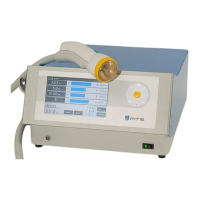52 MTS_OW100_IFU-orthogold100-US-K182682_A
To reduce the risk of cavitation, this device can only be used on
the extremities.
Applicator overheating may occur due to improper coupling,
transducer malfunction, etc. Discontinue use if the applicator or
treatment head is too hot to tolerate for either the physician or
patient.
1. Apply ultrasound gel onto the covered membrane of the applicator.
2. Select appropriate values for energy and frequency.
3. Bring the applicator in contact with the skin of the patient and release acoustic
waves.
4. The recommended paradigm is 2000 acoustic waves delivered per treatment
session. However, the health care provider must use their best judgment for the
patient based upon anatomy and treatment area.
Review the indications and contraindications before
beginning treatment.
Avoid air bubbles in the scope of acoustic waves!
The degree of tissue damage or hematomas is dependent upon
the applied total energy and the energy density. The water
membrane of the applicator should have very good contact to the
skin of the patient to avoid energy loss and the development of
hematomas.
Make sure that there are no air bubbles inside the water
membrane, especially in cases when the applicator is used in the
upward direction. Always use ultrasound gel and ensure that
there are no air bubbles between the water membrane and skin.
Air bubbles in the applicator
Applicator must be free of air bubbles!
To remove air bubbles, turn the applicator 30° downwards and
release some pulses.
To support the process knock softly with your finger onto the
membrane.

